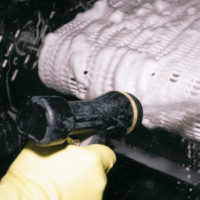Food manufacturers know that the easier it is to clean and sanitize food production lines, the better the overall sanitation result. Using the right conveyor belt designs facilitates easier, more effective cleaning, which helps plants meet strict sanitation standards as part of developing superior sanitation programs.
Gary Larsen, Technical Support Director for Hygienic Services, with Intralox Inc., LLC, the world’s largest, exclusive manufacturer of modular plastic conveyor belts, says that, for these reasons, the selection of an “easy-clean” belt and conveyor system can ultimately determine a plant’s success or failure in preventing conveyor sanitation problems. “The more “cleanable” the belt, the more you’ve reduced any potential food safety risks. Basically, if you can’t reach an area of the belt, you can’t clean it. Choosing conveyor and belt designs proven to facilitate better cleaning and sanitation will automatically increase control of food safety results.”
Larsen explains that Intralox focuses on helping plants gain more control over production efficiency, sanitation results and food safety. The Intralox belts’ smooth, non-porous plastics eliminate the bacteria traps common in flat rubber and fabric belts. Intralox’s positive sprocket drive system eliminates mistracking, which dramatically improves belt life and productivity for food plants. The company continues to raise the standard for efficient, effective belt sanitation with its growing family of EZ Clean Flat Top belts—Series 800, Series 1800, Series 800 Open Hinge, and Series 1600 Open Hinge.
“All suppliers now recognize the importance of food safety to their customers and are trying to meet these demands,” states Larsen. “When Intralox brings a technology to the market, it has been thoroughly tested to assure it accomplishes the intended task. A classic example is the open hinge. We recognized the advantage of making the hinge open to allow better access to difficult-to-reach areas. We knew our radius belts were easy to clean because of the slotted hinge. It seemed logical the slotted hinge would accomplish the same for our flat top belts. Testing proved otherwise. With a flat top belt, debris must be flushed across the width of the belt, so the slot became a trap. Testing showed the answer lay in using a cam to open the hinge without creating traps.”
Selecting the Right Belts for Your Application
Larsen recommends that food companies do their homework when choosing conveyor belts for hygienic applications because not all modular plastic belts produce superior sanitation results. He suggests asking potential suppliers the following questions to be sure their products are right for your operation:
1. Do the belt hinges open wide around the sprockets, but stay closed on the conveyor bed? Larsen notes that slotted open-hinge belt designs leave space for particles and scraps to accumulate. “This is why Intralox’s Series 800 Open Hinge Flat Top belts feature special Cam-link hinges, which are the most open of any modular plastic flat top belt on the market,” he says. “These hinges open wide around the sprockets to maximize cleaning access to the hinge area, but close on the conveyor bed to prevent debris from clogging the belt.”
2. Are the hinge openings large enough to allow spray to reach both the bottom and top surfaces? If not, water spray cannot reach all areas where soil or chemical residuals exist.
3. Do the belts allow catenary sag for better cleaning access, or must they be tensioned tightly against the conveyor surface? Catenary sag will enable better cleaning because the extra space allows more water spray to reach and loosen soils and scraps in the hinge area.
4. Do the belts include drive bars underneath to channel away water and debris? The benefit of underside drive bars, notes Larsen, is easy soil removal because water and debris are detoured to the outside of the belt and away from the production line.
5. Are the belts compatible with belt lifters? When lifting the belt, the conveyor should be off and locked out to prevent damage to the belt and possible injury to cleaning personnel. Belt lifting devices, either portable or frame mounted, lift the belt evenly across its width without causing damage to the belt. If the belt and the lifting method are not compatible, the belt will be damaged, resulting in a niche where soils and debris can hide.
6. Have the belts been tested for sanitation and cleaning under realistic plant conditions? It is important for easy-clean belt designs to be thoroughly tested to validate or improve their sanitation-friendly features. Larsen says, “For example, Intralox has a wet test facility dedicated exclusively to the scientific testing of plastic belt cleaning procedures and comparative testing of plastic and other belt technologies. The lab measures a number of cleanability factors, including water flow, cleaning time needed and water usage required, in order to realistically project how Intralox belts will increase sanitation success in a working plant environment.”
7. Will the belt company provide group seminars on sanitation issues and best cleaning practices? Notes Larsen, “The expertise of the belt company can help the processor go beyond basic sanitation goals. The Intralox Clean Team offers guidelines and seminars that advise food processors about sanitation-friendly conveyor design elements like low belt tension configurations for improved cleaning access and devices that facilitate debris removal. By providing educational information, we help facilities reduce sanitation-related costs without sacrificing hygiene standards.”
www.intralox.com
Selecting Easy-to-Clean Conveyor Belts for Superior Sanitation




